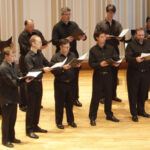10 AM Performance with Commentary by James Bagwell; with Bard Festival Chorale, James Bagwell, choral director; Alexander Bonus, organ; members of The Orchestra Now
Works by Giacomo Puccini (1858–1924), Laudate pueri (1741); Giovanni Pierluigi da Palestrina (c. 1525–1594) Assumpta est Maria (early 1590s); Orazio Vecchi (1550–1605), from L'Amfiparnaso (1594); Luca Marenzio (1553–1599) Basciami mille volte (1585) and Liquide perle, Amor, dagli occhi sparse (1580); Claudio Monteverdi (1567–1643) Ecco mormorar l'onde (1590); Carlo Gesualdo (1566–1613) Luci serene e chiare (1596); Antonio Vivaldi (1678–1741), Lauda Jerusalem (c. 1739); Giuseppe Verdi (1813–1901) from Quattro pezzi sacri (1898); and Ildebrando Pizzetti (1880–1968) from Messa di Requiem (1922)
Given the long dominance of the Roman Catholic Church, it should come as little surprise that Italy's choral tradition is so rich. Anchored by the Bard Festival Chorale, Program Nine, "Italian Choral Music since Palestrina," offers a generous sampling of four centuries of music. Italy enjoyed a flowering of sacred choral writing in the Renaissance, when the works of Giovanni Pierluigi da Palestrina, appointed maestro di cappella by the Pope, included an awe-inspiring 105 masses, 68 offertories, 35 magnificats, and more than 300 motets. Even those better known for their madrigals, like Orazio Vecchi and Luca Marenzio, also wrote significant numbers of motets and masses. Highlighted by the works of Carlo Gesualdo, Vivaldi, and Monteverdi, whose 1610 Vespers remains one of the crowning glories of the choral literature, this golden age continued into the Baroque. Monteverdi was also one of the founding fathers of Italian opera, and in his hands the stylistic boundaries between the genres became blurred. This trend reached its peak in the works of Verdi, whose choral output includes settings of the Te Deum and Stabat Mater, as well as his searingly operatic Requiem. Puccini himself, despite descending from four generations of professional church musicians, wrote remarkably little for choir, but his Messa di Gloria shows a similar synthesis of the liturgical and operatic. By contrast, Pizzetti's Requiem – scored for unaccompanied voices and featuring neo-Renaissance polyphony – reflects the 20th-century's newfound fascination with early music.

